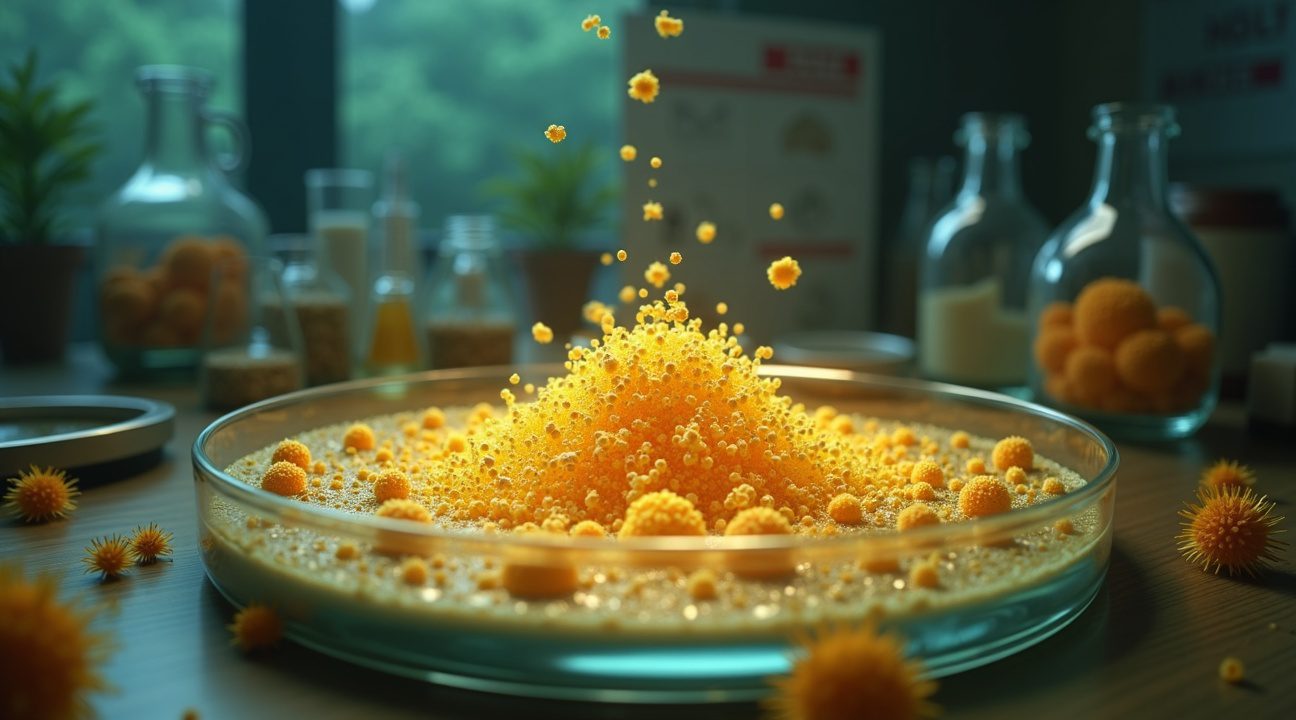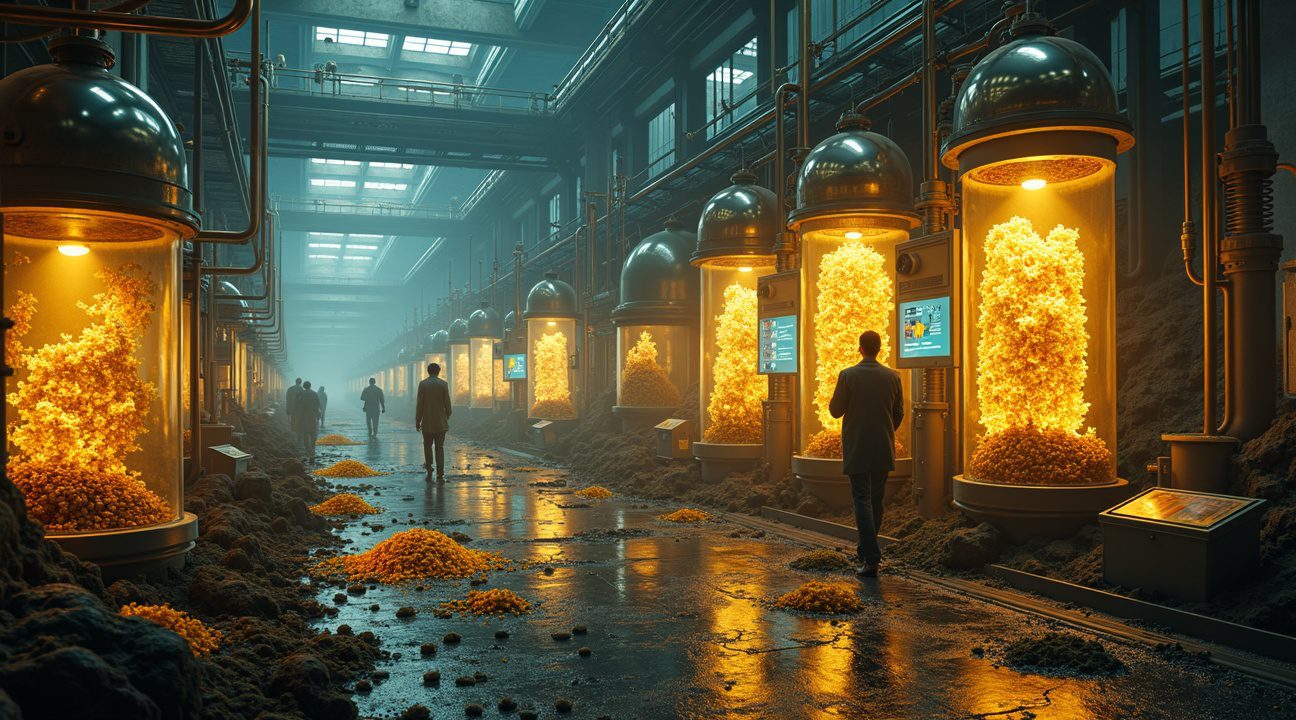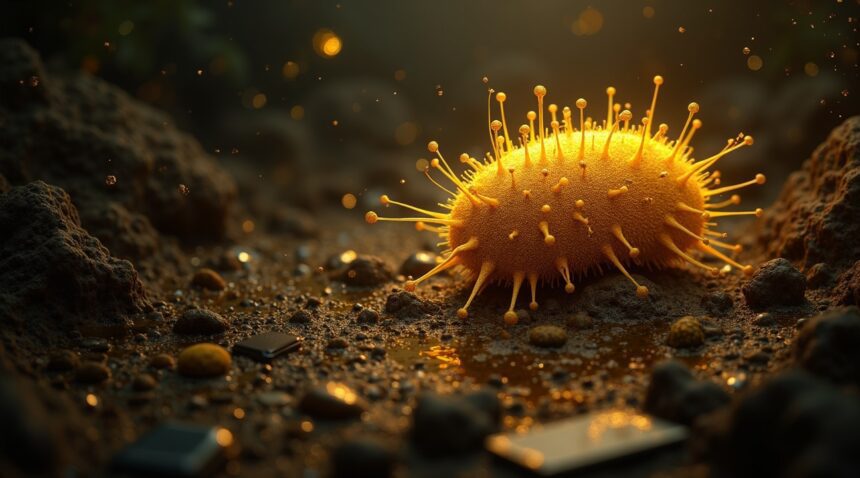Scientists have made a groundbreaking discovery involving Cupriavidus metallidurans, an extraordinary bacterium capable of converting toxic gold compounds into nearly pure gold nanoparticles in just seven days.
How Cupriavidus metallidurans Produces Gold
The bacterium Cupriavidus metallidurans has adapted to thrive in environments with high concentrations of heavy metals, an environment typically toxic to most life forms. Through its natural metabolic processes, it transforms gold chloride compounds into 99.9% pure gold nanoparticles.
Biological Mechanism and Enzymatic Role
This process hinges primarily on the enzyme CopA, which enables the bacterium to reduce harmful gold ions and form harmless metallic nanoparticles. These nanoparticles range from 25 to 50 nanometers in size and are deposited on the bacterium’s exterior.
Genetic Adaptations for Heavy Metal Resistance
Cupriavidus metallidurans is equipped with two specialized plasmids, known as pMOL28 and pMOL30. These plasmids provide robust resistance against multiple types of heavy metals, allowing the bacterium to survive and even thrive in severe chemical conditions.
- pMOL28 and pMOL30 help defend against metals such as cadmium, copper, nickel, and silver.
- Additional resistance to lead, mercury, and zinc further enhances survival.
Potential and Limitations of Gold-Producing Bacteria
Although this microbial process offers a cleaner and safer alternative to traditional gold mining, it’s important to understand its practical limitations as well as its promise.
Environmental and Industrial Benefits
- Eco-friendly alternative to harmful methods involving mercury and cyanide.
- Promising use in processing electronic waste and low-grade ores.
Current Limitations and Future Prospects
- The bacteria transform only existing gold-based compounds—they do not create gold from other elements.
- Applications are still limited to laboratory-scale production.
- Future developments may allow environmental cleanups that recover valuable metals, combining ecological and economic benefits.
For more details on this unique bacterium and its potential applications, you may explore the original research through trusted resources such as this Nature Scientific Reports article.
This “Gold-Pooping” Bacterium Converts Deadly Toxins Into 24-Carat Gold in Just One Week
Scientists have discovered that a remarkable microorganism called Cupriavidus metallidurans can transform lethal metal compounds into pure gold through what researchers describe as microbial alchemy. This extraordinary bacterium literally converts toxic gold chloride into 99.9% pure metallic gold nanoparticles, earning it the colorful nickname of “gold-pooping bacteria.”
The groundbreaking research, published in the journal Metallomics, demonstrates how this microbe can yield 24-carat gold in just seven days. Researchers Kazem Kashefi and Adam Brown at Michigan State University showcased this incredible process through their installation called “The Great Work of the Metal Lover”, which visually demonstrates the bacterium’s ability to create precious metal from poisonous compounds.
From Factory Sludge to Scientific Marvel
Cupriavidus metallidurans wasn’t discovered in some exotic location—scientists first isolated it in 1976 from metal-processing factory sludge. However, its gold-forming capabilities remained hidden until 2009, when researchers uncovered this bacterium’s unique talent for converting toxic metals into pure gold nanoparticles. Research into this fascinating microorganism continues through 2025, with scientists exploring its potential applications.
The bacterium’s survival mechanism is what makes it so valuable. Unlike most organisms that would die when exposed to toxic metal compounds, Cupriavidus metallidurans has evolved to not just survive but actually thrive in these hostile environments. The microbe essentially eats the toxic metals and excretes pure gold as a byproduct of its metabolic processes.
Collaborative Research Reveals Gold Production Process
Scientists from multiple institutions, including Michigan State University, the University of Adelaide, and Martin Luther University Halle-Wittenberg, have collaborated to understand exactly how this process works. Their research reveals that the bacterium’s cellular machinery processes the toxic compounds through specialized enzymes, ultimately producing pure gold nanoparticles that can be harvested.
This discovery has significant implications for both environmental cleanup and precious metal production. While deep-sea research continues to reveal new organisms, few discoveries match the practical potential of this gold-producing bacterium. The process could revolutionize how we approach toxic waste remediation while simultaneously creating valuable materials.
The bacterium’s ability to work with various toxic metals beyond gold chloride suggests broader applications for environmental restoration. Scientists continue investigating whether similar technological advances could enhance the efficiency of this natural gold production process.

How This Remarkable Microbe Transforms Lethal Metals Into Precious Gold Nanoparticles
C. metallidurans has evolved an extraordinary survival strategy that turns deadly poison into precious treasure. This bacterium doesn’t just tolerate heavy metals—it actively transforms them through a sophisticated biological process that would make any alchemist envious.
The Bacterium’s Toxic Metal Environment
Most organisms would perish instantly in the extreme conditions where C. metallidurans thrives. Heavy metals like copper and gold create hostile environments that destroy cellular structures and disrupt vital biological processes. Gold ions, particularly those found in gold chloride compounds, prove especially lethal because they interfere with protein function and damage cell membranes. Yet this remarkable microbe has turned this deadly challenge into an opportunity, much like how artificial intelligence paving the way transforms complex problems into solutions.
C. metallidurans encounters these toxic conditions in mining waste sites, contaminated soils, and areas with high mineral concentrations. The bacterium’s ability to survive requires constant defense against metal poisoning that would eliminate competing microorganisms within minutes.
The Gold Transformation Process
The bacterium’s defense mechanism operates through a precise enzymatic system centered around the CopA enzyme. When toxic gold ions penetrate the cell, this specialized enzyme immediately springs into action, reducing harmful ionic gold into harmless metallic forms. The process follows these critical steps:
- Gold ions enter through the same cellular pathways used for copper transport
- CopA enzyme rapidly reduces toxic gold ions before they can cause cellular damage
- The detoxification process converts ionic gold into solid metallic nanoparticles
- Gold nanoparticles measuring 25–50 nanometers precipitate on the cell’s exterior surface
- The bacterium continues normal cellular functions while wearing its golden armor
This enzymatic conversion represents one of nature’s most efficient detoxification systems. The CopA enzyme doesn’t distinguish between copper and gold initially, treating both metals through similar reduction pathways. However, while copper gets processed internally for cellular functions, gold gets expelled as pure metallic nanoparticles.
The resulting gold particles maintain remarkable purity and uniformity in size. Scientists have observed that these biological nanoparticles often exceed the quality of synthetically produced gold, making them valuable for electronics and medical applications. The bacterium essentially creates a living gold factory, continuously processing toxic waste into valuable materials while protecting itself from metal poisoning.
This natural process demonstrates how researchers find extraordinary adaptations in extreme environments, where survival pressures drive evolution toward remarkable solutions.
The Genetic Superpowers Behind This Metal-Eating Marvel
I’ve discovered that C. metallidurans possesses an extraordinary genetic toolkit that sets it apart from ordinary bacteria. This remarkable microorganism carries two specialized plasmids—pMOL28 and pMOL30—that encode resistance to an impressive array of heavy metals including cadmium, copper, nickel, silver, lead, mercury, and zinc. These genetic elements function as the bacterium’s survival arsenal, providing broad adaptability to toxic environments that would prove lethal to most other microorganisms.
The multi-metal resistance encoded by these plasmids represents a sophisticated biological defense system. Each plasmid contains specific gene clusters that work in tandem to neutralize different metallic threats. This genetic redundancy ensures the bacterium can handle multiple toxic exposures simultaneously, much like artificial intelligence systems that process multiple data streams concurrently.
Genetic Architecture of Metal Resistance
The associated gene clusters within pMOL28 and pMOL30 create a comprehensive resistance network that makes C. metallidurans a model organism for studying microbial adaptation to heavy metal stress environments. Scientists have identified that these plasmids don’t just provide basic survival—they enable the bacterium to thrive in conditions where metal concentrations reach levels toxic to virtually all other life forms.
This genetic adaptability positions C. metallidurans as a true extremophile, capable of surviving in environments ranging from contaminated mining sites to industrial waste areas. The bacterium’s ability to maintain stable populations in such harsh conditions demonstrates the power of its genetic superpowers. Unlike research on deep-sea organisms that adapt to pressure extremes, this bacterium has evolved to handle chemical extremes.
The genetic resilience encoded by these plasmids allows the bacterium to survive in environments that would kill ordinary bacteria within minutes. This survival capability makes it particularly significant for metal detoxification applications, where traditional biological remediation methods fail. Industries dealing with heavy metal contamination now view this bacterium as a potential game-changer for environmental cleanup efforts.
I find it fascinating that the bacterium’s genetic architecture represents millions of years of evolutionary refinement. The plasmids can transfer between bacterial cells, spreading resistance genes throughout microbial communities. This horizontal gene transfer mechanism ensures that metal resistance traits persist and expand within bacterial populations exposed to toxic metals.
The practical implications of understanding these genetic superpowers extend far beyond academic curiosity. Researchers can now engineer similar resistance mechanisms in other microorganisms, potentially creating specialized bacteria for specific metal extraction or detoxification tasks. The knowledge gained from studying C. metallidurans has already influenced biotechnology approaches to environmental remediation.
Scientists have also noted that the bacterium’s genetic flexibility allows it to adapt to new metal challenges over time. When exposed to novel metal combinations, the organism can modify its resistance mechanisms through genetic mutations and plasmid evolution. This adaptability ensures the bacterium remains effective even as industrial metal pollution patterns change.
The multi-metal resistance encoded by pMOL28 and pMOL30 represents more than simple survival—it enables active metal processing that transforms toxic substances into valuable resources. This genetic capability bridges the gap between environmental cleanup and resource recovery, making the bacterium valuable for both ecological restoration and economic applications. The bacterium’s genetic superpowers continue to reveal new possibilities as researchers explore its full potential for addressing modern environmental challenges.
Revolutionary Green Mining: How Bacteria Could Replace Toxic Chemicals in Gold Extraction
Traditional gold mining has relied on dangerous chemicals like mercury and cyanide for decades, leaving behind contaminated landscapes and poisoned water systems. A dramatic shift is emerging as scientists harness the power of C. metallidurans and other specialized bacteria to extract gold without devastating environmental consequences.
Bioleaching and Biomining Transform Gold Recovery
Bioleaching represents a fundamental change in how gold is extracted from challenging sources. This process utilizes bacteria such as C. metallidurans and Acidithiobacillus ferrooxidans to naturally break down metal-containing compounds, allowing gold recovery without harsh chemical interventions. The bacteria essentially consume their way through rock and ore, creating conditions where gold becomes accessible for collection.
Key advantages of bacterial gold extraction include:
- Processing low-grade ores that traditional methods can’t handle economically
- Recovering gold from electronic waste and discarded mining materials
- Operating at ambient temperatures with minimal energy requirements
- Eliminating mercury and cyanide from the extraction process
- Reducing water contamination and soil toxicity
Biomining techniques using these bacteria show particular promise for electronic waste processing. Advanced technological solutions combined with bacterial processes could revolutionize how precious metals are recovered from discarded smartphones, computers, and circuit boards.
The environmental benefits extend far beyond chemical reduction. Traditional mining operations destroy habitats, create acid mine drainage, and generate toxic waste that persists for generations. Bacterial extraction operates with significantly lower environmental impact, preserving ecosystems while still accessing valuable gold reserves.
Commercial applications are already emerging in several countries, with pilot programs demonstrating successful gold recovery from previously unusable ore deposits. These operations show that bacteria can process materials with gold concentrations as low as 0.5 grams per ton, making previously uneconomical deposits viable.
Research continues expanding bacterial applications beyond simple extraction. Scientists are exploring the use of engineered bacterial colonies to concentrate gold particles, creating more efficient collection methods. Deep-sea research has revealed additional bacterial species with metal-processing capabilities that could enhance future biomining operations.
The shift represents more than environmental protection—it offers economic advantages through reduced chemical costs, lower regulatory compliance expenses, and access to previously untapped gold sources. Mining companies increasingly recognize that bacterial extraction provides sustainable competitive advantages while meeting growing environmental regulations and consumer demands for responsible sourcing.
https://www.youtube.com/watch?v=-y7XB2rF7uo

What This Discovery Can’t Do: Separating Science From Science Fiction
I need to address the significant gap between what this bacterial discovery actually accomplishes and the golden fantasies it might inspire. While Cupriavidus metallidurans represents a genuine scientific breakthrough, it operates within strict chemical boundaries that prevent it from becoming a biological money printer.
The bacteria can only work with gold that already exists in chemical form, specifically compounds like gold chloride. I can’t stress this enough: these microorganisms transform existing gold compounds rather than creating gold from thin air. The process involves converting toxic gold salts into pure metallic gold through bacterial metabolism, but the gold atoms must be present from the start. This fundamental limitation means the bacteria function more like biological refineries than magical gold generators.
Understanding the Reality of Bacterial Gold Production
The output from these remarkable microorganisms consists of gold nanoparticles, not the gleaming nuggets or mint-ready coins that popular imagination might conjure. These nanoparticles measure just billionths of a meter across, requiring sophisticated equipment to even detect their presence. While nanoparticles have valuable applications in electronics and medicine, they don’t translate directly into the kind of bulk gold that drives economic markets.
Scaling this process for industrial use presents enormous challenges that researchers haven’t yet solved. Laboratory conditions that allow bacteria to thrive and produce gold nanoparticles differ vastly from the requirements of large-scale operations. Factors like:
- Nutrient supply
- Waste management
- Contamination control
- Particle harvesting
become exponentially more complex when moving from petri dishes to industrial bioreactors.
Economic viability remains questionable even if scaling hurdles get cleared. The energy costs, infrastructure requirements, and time needed for bacterial gold production could exceed the value of the gold produced. Current research suggests that while fascinating from a scientific perspective, this bacterial process may never compete with traditional mining or chemical extraction methods in terms of cost-effectiveness.
I want to emphasize that this discovery represents true microbial transformation rather than fictional alchemy. Unlike the ancient dream of transmuting base metals into gold, these bacteria work within established chemical principles. They reduce gold ions to metallic form through cellular processes, similar to how artificial intelligence transforms data rather than creating it from nothing.
The bacteria’s ability extends beyond gold to other toxic metals, which actually holds more immediate practical promise than gold production. Cupriavidus metallidurans can help remediate contaminated environments by processing various heavy metals into less harmful forms. This environmental application could prove more valuable than any gold-related benefits.
Scientists continue studying these bacteria not because they expect to revolutionize gold mining, but because they offer insights into extremophile biology and potential biotechnology applications. The organisms demonstrate how life adapts to harsh conditions and performs chemistry that humans find difficult to replicate efficiently.
Future research will likely focus on understanding the exact mechanisms behind metal processing rather than maximizing gold output. The bacterial enzymes and cellular processes responsible for metal transformation could inspire new industrial catalysts or environmental cleanup technologies.
The distinction between transformation and creation matters enormously in scientific contexts. While researchers find extraordinary capabilities in extreme environments, they remain bound by fundamental physical laws. These bacteria demonstrate remarkable adaptation and useful chemistry, but they can’t violate conservation of mass or energy.
This bacterial discovery joins other fascinating biological phenomena that capture public imagination while maintaining scientific rigor. The gap between laboratory curiosity and practical application often spans decades, if it closes at all. Understanding these limitations helps maintain realistic expectations while appreciating the genuine scientific value of discoveries like Cupriavidus metallidurans and its unique relationship with precious metals.
The Future of Microbial Gold Mining and Environmental Applications
I find the potential applications of C. metallidurans extend far beyond traditional mining operations. Researchers are actively working to optimize these remarkable bacteria for gold recovery from sources previously considered uneconomical or inaccessible. Electronic waste, mining tailings, and low-grade ore deposits could become valuable resources through biological processing methods that harness the natural metal-eating capabilities of these microorganisms.
The optimization process involves enhancing bacterial efficiency in converting toxic metal compounds into recoverable gold nuggets. Scientists are experimenting with controlled environments that maximize bacterial activity while maintaining stable colony populations. These efforts focus on creating scalable systems that can process larger volumes of material while preserving the bacteria’s unique metallurgical properties.
Revolutionary Applications in Biotechnology and Environmental Solutions
The implications of this bacterial discovery stretch across multiple industries and environmental challenges. Electronic recycling facilities could integrate microbial gold recovery systems to extract precious metals from discarded smartphones, computers, and other devices. This approach offers a sustainable alternative to harsh chemical processes currently used in e-waste processing, while artificial intelligence paving the way could optimize these biological systems for maximum efficiency.
Environmental remediation represents another promising application. C. metallidurans can potentially clean contaminated sites while simultaneously recovering valuable metals, creating economic incentives for environmental restoration projects. Mining companies could deploy these bacteria to process legacy waste streams, transforming environmental liabilities into profit centers.
The biogeochemical cycling insights gained from studying these extremophiles reveal new understanding about how metals move through natural systems. This knowledge helps scientists predict where gold deposits might form naturally and guides the development of bio-inspired extraction technologies. Just as researchers find essential building blocks in unexpected places, these bacteria reveal hidden pathways for metal concentration in nature.
Extremophile biotechnology applications extend beyond gold recovery. The survival strategies these bacteria employ in toxic environments could inform development of microorganisms capable of processing other valuable materials or cleaning up different types of contamination. Their resilience mechanisms might contribute to advances in industrial biotechnology, where robust microorganisms are essential for consistent production processes.
Future mining technology integration involves combining bacterial processing with conventional extraction methods. Hybrid systems could use bacteria for initial concentration steps, followed by traditional refining processes for final purification. This approach reduces the environmental impact of mining operations while potentially accessing previously untapped resources.
The scalability challenges remain significant, as laboratory successes must translate into industrial applications. Researchers are developing bioreactor designs that maintain optimal conditions for bacterial activity while processing commercial volumes of material. These systems require careful monitoring of temperature, pH, nutrient levels, and bacterial population dynamics to ensure consistent performance.
Economic modeling suggests microbial gold recovery could become commercially viable within a decade, particularly in the following areas:
- High-value, low-volume applications such as circuit board processing
- Remote or small-scale operations where traditional mining is not feasible
- Environmentally focused initiatives incentivized by regulation or carbon credits
The technology’s environmental benefits provide additional value that traditional cost-benefit analyses might not fully capture.
Research collaboration between microbiologists, metallurgists, and environmental engineers accelerates development of practical applications. These interdisciplinary teams are addressing challenges ranging from bacterial cultivation techniques to process engineering and regulatory compliance. Their work parallels other breakthrough discoveries, much like how researchers find extraordinary specimens in extreme environments.
The integration of microbial gold mining into existing industrial processes requires careful consideration of infrastructure modifications and operational procedures.
- Facilities must incorporate bioreactors and monitoring systems
- Operators need training in biological process management
- Processes must meet biosafety and environmental standards
This integration presents both technical challenges and opportunities for innovation in industrial design.
Understanding extremophile survival strategies contributes to broader biotechnology applications beyond metal processing. These insights could advance development of microorganisms for pharmaceutical production, environmental monitoring, or space exploration applications where organisms must function in hostile environments.

Sources:
Geologyin, “Researchers Discover Bacteria That Transform Toxins into Pure Gold”
Pressemitteilungen PR Universität Halle, “These Bacteria produce gold by digesting toxic metals”
PMC, “Cupriavidus metallidurans: A Modern Alchemist”
Phys.org, “Bacteria produce gold by digesting toxic metals”
Edinbox, “Tiny Bacteria Found That Poop’s Gold: Latest Discoveries in 2025”
ScienceAlert, “These Bacteria Digest Toxic Metals And Poop Out Tiny Gold Nuggets”
Jagran Josh, “This bacteria can convert heavy metals into gold. Check details here!”


